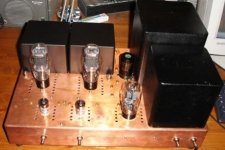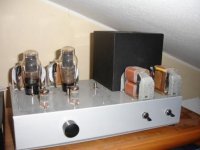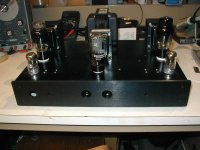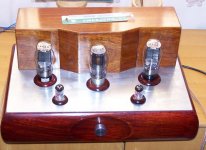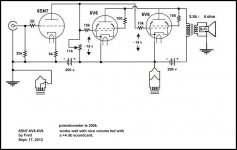I have Jean Hiraga's book (in French) which has been an inspiration to me on numerous ocassions.
I recently designed and built a 2A3 amplifier based on a loose interpretation of the Loftin White approach. Mine has a choke assisted mu follower driver direct coupled to the 2A3 output tube. The driver tube is a 7N7 (6SN7 loctal version) I have box plate Kenrad 2A3 from the 1940's. The power supply and output tube cathode bypass caps are 100uF ASC PPIO, supply is CLC with GZ32 rectifier. It was just great with a pair of JBL Rhodes C37 speakers and works well, but not great with my current Onken bass /JBL4333 mid horn /JBL2402 ART setup.
Gain is a bit marginal, but ok in my system and given the amplifier's limited output power.
Here is a pix of it. A very simple design..
I recently designed and built a 2A3 amplifier based on a loose interpretation of the Loftin White approach. Mine has a choke assisted mu follower driver direct coupled to the 2A3 output tube. The driver tube is a 7N7 (6SN7 loctal version) I have box plate Kenrad 2A3 from the 1940's. The power supply and output tube cathode bypass caps are 100uF ASC PPIO, supply is CLC with GZ32 rectifier. It was just great with a pair of JBL Rhodes C37 speakers and works well, but not great with my current Onken bass /JBL4333 mid horn /JBL2402 ART setup.
Gain is a bit marginal, but ok in my system and given the amplifier's limited output power.
Here is a pix of it. A very simple design..
Attachments
This thread seems to keep resurfacing with lots of nice L-W photos! Also interested to see the circuit Kevin has come up with.
Wondering what capacitors you L-W amp builders are using?
Been doing some cathode bypass cap rolling the last couple of days. Bypass caps make a very noticable difference to the sound of my L-W.
Here are my subjective findings with the caps I had on hand.
2A3 (100uf 250V)
#1 Panasonic NHG
#2 Panasonic EB (rolled off highs, distorted)
6SL7 (100uf 16V)
#1 Panasonic NHG
#2 Panasonic FC (similar sound to NHG, but slightly irritating)
#3 Nichicon Muse ES Bipolar (rolled off highs, dull)
The NHG's for both output & driver sound the best to me of the limited number of caps I tried.
Comments?
Wondering what capacitors you L-W amp builders are using?
Been doing some cathode bypass cap rolling the last couple of days. Bypass caps make a very noticable difference to the sound of my L-W.
Here are my subjective findings with the caps I had on hand.
2A3 (100uf 250V)
#1 Panasonic NHG
#2 Panasonic EB (rolled off highs, distorted)
6SL7 (100uf 16V)
#1 Panasonic NHG
#2 Panasonic FC (similar sound to NHG, but slightly irritating)
#3 Nichicon Muse ES Bipolar (rolled off highs, dull)
The NHG's for both output & driver sound the best to me of the limited number of caps I tried.
Comments?
Hi 5U4,
I noticed much the same thing in designing my amplifier. I tried several panasonic electrolytics and they all sounded harsh.
Ended up with ASC 100uF PPIO (motor run cap) on the output tubes from cathode to ground and 20uF Solen from cathode to B+ (ripple cancelling) adding the solen made a big difference - things just opened up and also got a lot cleaner sounding. The ASC by itself sounded clean, but rolled off.
Driver stage uses relatively cheap rubycon blackgate for cathode bypass.
I noticed much the same thing in designing my amplifier. I tried several panasonic electrolytics and they all sounded harsh.
Ended up with ASC 100uF PPIO (motor run cap) on the output tubes from cathode to ground and 20uF Solen from cathode to B+ (ripple cancelling) adding the solen made a big difference - things just opened up and also got a lot cleaner sounding. The ASC by itself sounded clean, but rolled off.
Driver stage uses relatively cheap rubycon blackgate for cathode bypass.
Kevin,
Can I ask you for the schematic...
I always curious with the sound of 2A3 and 6SN7....
Thank you very much
Ferry
Hello Ferry,
The two tubes you mention are each LOVELY performers, very neutral. However, it is an error to combine them in a two stage DC amp, as there is NOT enough gain.
Ohh yes, the amp will pass a signal, but it will only sound good when pushed....which gets "old" fast. The most livable two stage L-W type tube choices would use a mu of 70 or higher triode as the driver tube.
This will be perceived as being a LIVELY and vivacious sounding amp, even at low levels.
A wonderful and easy choice with a 2A3 would be 1/2 of a 12AX7 ( mu of 100 ) operating at 170 to 195 VDC Ea, 1.70-1.80 VDC Ek, and about .0006 Ia. It will sound very engaging....good, even at low listening levels. Half a 6SL7WGT is also a candidate, prefer the 12AX7's gain however, with a 2A3.
Jeff Medwin
Hi Jeff
I have a bunch of 12SF5, Have you tried them and if so how they compare to the 12AX7 in a LW circuit ?
No, sorry, I have never tried that tube. I stick with readily available tubes, and one can roll AX7s till de cowz come home.
Jeff Medwin
No, sorry, I have never tried that tube. I stick with readily available tubes, and one can roll AX7s till de cowz come home.
Jeff Medwin
quinnling,
Look up the build article on L-W amps from 1947, by Messers J. Robin and R. Lipman, entitled " Practical Amplifier Designs", a little two dollar book with over 40 circuits:
They used a 6SF5 DCed into a 6B4G. I assume the 12SF5 is a 12 VAC filament version of a 6SF5. So YES, you could use it.
The question I always ask is, does it make financial and practical sense to build an amp around a scarce tube you have in your stash??
I feel the answer is NO. Especially after you hear some of the better 12AX7s in this world, like a ( pick your favorite: ) Telefunken smooth plate, vintage Amperex, Mullards, and some of the earliest RCAs.
If you want to build such a DC amp, contact me privately and I'll send you a unpublished write up I have done.
Jeff Medwin
6SN7-6V6-6V6 Loftin White with stacked supplies.
Hi. I hope nobody minds that I add this here. It is basically a Loftin White but I have replaced the bypassed cathode resistor of the 2nd power tube with a power supply and stacked another power supply on top for the plate of power tube. The load resistor of the 6SN7 also biases the 6V6's so it is very much the same.
My intent with the two power supplies is to further isolate the current loops in the circuit and allow easier adjustment of the plate voltages etc. The circuit is very easy to put together. I biased it by adjustment and measurement on the bench.
Also I like to use choke input filter power supplies with circuits with low power supply rejection and a 500 volt choke input supply is a tall order for me. But two stacked choke input supplies presented no difficulties whatsoever.
The transformer is a one-electron 3.5k and it seems to work well with the parallel 6V6's. The sensitivity is low and works well with a +4 db soundcard. I like this since I listen to headphones out of the same soundcard directly and this way I don't have to change my soundcard output settings.
I believe I'll be building a case for this one. I think it's a keeper. It's largely a junkbox build but I think I'll keep it fully adjustable with meters so different tubes can be used.
I'm listening to Messiaen on it as I type and it's lovely. Thanks for looking. -Fred
Hi. I hope nobody minds that I add this here. It is basically a Loftin White but I have replaced the bypassed cathode resistor of the 2nd power tube with a power supply and stacked another power supply on top for the plate of power tube. The load resistor of the 6SN7 also biases the 6V6's so it is very much the same.
My intent with the two power supplies is to further isolate the current loops in the circuit and allow easier adjustment of the plate voltages etc. The circuit is very easy to put together. I biased it by adjustment and measurement on the bench.
Also I like to use choke input filter power supplies with circuits with low power supply rejection and a 500 volt choke input supply is a tall order for me. But two stacked choke input supplies presented no difficulties whatsoever.
The transformer is a one-electron 3.5k and it seems to work well with the parallel 6V6's. The sensitivity is low and works well with a +4 db soundcard. I like this since I listen to headphones out of the same soundcard directly and this way I don't have to change my soundcard output settings.
I believe I'll be building a case for this one. I think it's a keeper. It's largely a junkbox build but I think I'll keep it fully adjustable with meters so different tubes can be used.
I'm listening to Messiaen on it as I type and it's lovely. Thanks for looking. -Fred
Attachments
You will need a plate (Anode) load resistor from the first stage plate to 290V B+ or the input stage will not function.
The bias scheme for the output tubes will now work as the anode supply of the first stage has to be greater than the grid voltage, ie it will force a positive bias.
I suggest you go back and study the original Loftin-White schematic for how each stage is biased.
The bias scheme for the output tubes will now work as the anode supply of the first stage has to be greater than the grid voltage, ie it will force a positive bias.
I suggest you go back and study the original Loftin-White schematic for how each stage is biased.
I'm sorry, I don't see the error. The anode resistor for the 6SN7 is the pot in the circuit. I may have made a mistake in the schematic but I don't see it. Thanks for looking at it. 
Edit: There are two power supplies. The voltage drop across the anode resistor for the 6SN7 is coming from the bottom 200v supply.
Edit: There are two power supplies. The voltage drop across the anode resistor for the 6SN7 is coming from the bottom 200v supply.
Last edited:
If you use the 11K pot as the anode resistor for the first stage, you will produce high levels of distortion as you are close to cutoff of the tube with only 15V of headroom.
You should be running around 8-10mA current in the 6SN7. However with a 6K cathode resistor you are going to be down below 2mA, and probably close to 1.3mA. 1.3mA would give you 14.7V bias to the 6SN7, but look at the load line and where you are biased.
Take a look at the load line, which runs from 11.76mA on the left at 0V to 200V and 0ma on the bottom. Your bias point is around 185V.
(I would attach a graph, but I can't from work.)
Go here and look at the bottom graph.
http://www.hifitubes.nl/weblog/wp-content/tung-sol-6sn7.pdf
Draw your load line on it.
You should be running around 8-10mA current in the 6SN7. However with a 6K cathode resistor you are going to be down below 2mA, and probably close to 1.3mA. 1.3mA would give you 14.7V bias to the 6SN7, but look at the load line and where you are biased.
Take a look at the load line, which runs from 11.76mA on the left at 0V to 200V and 0ma on the bottom. Your bias point is around 185V.
(I would attach a graph, but I can't from work.)
Go here and look at the bottom graph.
http://www.hifitubes.nl/weblog/wp-content/tung-sol-6sn7.pdf
Draw your load line on it.
Last edited:
Replace the pot with a 100K resistor, and run a 220K resistor from the anode of the first tube to the 290V B+.
Now your loadline runs from 490V to 2.22mA. It is near horizontal and provides a much more linear output.
You also will not have to worry about running your driver to cutoff.
Now your loadline runs from 490V to 2.22mA. It is near horizontal and provides a much more linear output.
You also will not have to worry about running your driver to cutoff.
Last edited:
Member
Joined 2009
Paid Member
The most livable two stage L-W type tube choices would use a mu of 70 or higher triode as the driver tube.
Hi Jeff,
Ever tried the 6AN4. High mu, and with current drive to spare ?
- Status
- This old topic is closed. If you want to reopen this topic, contact a moderator using the "Report Post" button.
- Home
- Amplifiers
- Tubes / Valves
- Loftin-White
